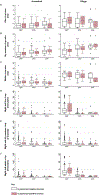Predictors of bovine Schistosoma japonicum infection in rural Sichuan, China
- PMID: 35644269
- PMCID: PMC9250636
- DOI: 10.1016/j.ijpara.2022.04.002
Predictors of bovine Schistosoma japonicum infection in rural Sichuan, China
Abstract
In China, bovines are believed to be the most common animal source of human schistosomiasis infections, though little is known about what factors promote bovine infections. The current body of literature features inconsistent, and sometimes contradictory results, and to date, few studies have looked beyond physical characteristics to identify the broader environmental conditions that predict bovine schistosomiasis. Because schistosomiasis is a sanitation-related, water-borne disease transmitted by many animals, we hypothesised that several environmental factors - such as the lack of improved sanitation systems, or participation in agricultural production that is water-intensive - could promote schistosomiasis infection in bovines. Using data collected as part of a repeat cross-sectional study conducted in rural villages in Sichuan, China from 2007 to 2016, we used a Random Forests, machine learning approach to identify the best physical and environmental predictors of bovine Schistosoma japonicum infection. Candidate predictors included: (i) physical/biological characteristics of bovines, (ii) human sources of environmental schistosomes, (iii) socio-economic indicators, (iv) animal reservoirs, and (v) agricultural practices. The density of bovines in a village and agricultural practices such as the area of rice and dry summer crops planted, and the use of night soil as an agricultural fertilizer, were among the top predictors of bovine S. japonicum infection in all collection years. Additionally, human infection prevalence, pig ownership and bovine age were found to be strong predictors of bovine infection in at least 1 year. Our findings highlight that presumptively treating bovines in villages with high bovine density or human infection prevalence may help to interrupt transmission. Furthermore, village-level predictors were stronger predictors of bovine infection than household-level predictors, suggesting future investigations may need to apply a broad ecological lens to identify potential underlying sources of persistent transmission.
Keywords: Buffalo; Cattle; China; Machine learning; Prevention and control; Schistosomiasis.
Copyright © 2022 The Author(s). Published by Elsevier Ltd.. All rights reserved.
Figures





References
-
- Al-Gaabary M, Osman S, El-Tonoby A, 2009. Studies on paramphistomiasis in ruminants. Kafrelsheikh Vet Med J 7, 116–136.
-
- Alemneh T, Engdaw, Alemseged G, Abuhay, 2015. Overview on: Schistosoma infection in cattle. World J Pharm Res 1, 1–11.
-
- Biau G, Scornet E, 2016. A random forest guided tour. TEST 25, 197–227.
-
- Breiman L, Cutler A, 2011. Manual: Setting up, using, and understanding random forests V4.0 Accessed Sep 8, 2020: https://wwwstatberkeleyedu/~breiman/Using_random_forests_v40pdf.
Publication types
MeSH terms
Substances
Grants and funding
LinkOut - more resources
Full Text Sources

